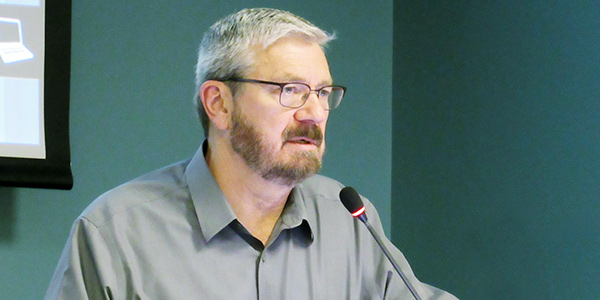By Amanda Durish Cook
CARMEL, Ind. — A recent MISO workshop on storage providing transmission services made clear how much the technology is blurring the once clear lines between generation and transmission.
In opening the Oct. 31 workshop, MISO Director of Planning Jeff Webb jokingly nodded to the industry’s choice of “SATA” as shorthand for “storage as a transmission asset,” saying: “Happy Halloween. Welcome to what we’re calling SATAN’s workshop.”
MISO last month detailed how SATA would be evaluated in its annual Transmission Expansion Plan reliability studies compared with traditional solutions. The RTO is proposing that costs for storage projects selected as a preferred transmission solution would be recovered in local transmission zonal rates while avoiding double recovery for the same service in the energy market. (See MISO Contemplates Storage as Tx Reliability Asset.)
“I don’t expect … that we’re going to have a lot of energy storage resources that we’re going to consider to be the preferred option,” Webb said.
For now, MISO is only proposing a model for storage to act as a transmission reliability solution, solving thermal, voltage or stability issues. Beyond that, Webb said the RTO will have to pick through more complex Tariff issues.
He said it will hold off on discussions around evaluating storage as economic transmission, competitive storage projects and how regional cost sharing for high-voltage transmission projects applies to storage.
The Interconnection Question
MISO has laid out potential paths for interconnecting SATA, including only requiring the MTEP process — not the interconnection queue — for transmission-only assets. An interconnection queue requirement would kick in if a storage owner decides to begin offering market services.
Alternatively, MISO could require entering the interconnection queue for all SATA, even for assets that don’t plan on participating in the energy market, Webb said. Some stakeholders also contend that SATA providing some market services should not be subject to a queue requirement unless it plans to offer capacity.
For a storage asset that has completed the interconnection queue, MISO has proposed that the owner could decide to provide market services when the RTO doesn’t need transmission services. Webb said it’s “you’re a wire unless we say you’re not” philosophy, similar to CAISO’s approach. (See CAISO Updates Storage as Transmission Asset Plan.) MISO must also determine how registration should differ between transmission and generation storage assets.
“There seems to be a fair amount of passion around these issues, particularly around interconnection issues,” Webb said. “There are those that say if you’re going to treat it as a wire, treat it as a wire. Don’t treat it the way it acts; treat it the way it’s categorized.”
Webb said that if storage-as-wires is required to enter the interconnection queue, it may have to compete for scarce transmission capacity with other proposed generation, potentially disadvantaging other generators.
He also noted that the approximately three-year backlog in the queue might hinder the ability for storage resources to go in service more quickly than traditional transmission lines. He said MISO could also add steps to the MTEP process that consider the potential impact of SATA on queued generation. Webb said MTEP studies could capture even the benefits of energy withdrawals to potential generation.
“That unloading of the line will probably be beneficial for generations seeking to load up that line,” Webb said. “Part of the problem with getting your head around these devices … is optimal location on the system.”
MISO has said that if storage would “negatively impact potentially interconnecting generation in the area, it is not a good MTEP solution.”
But Customized Energy Solutions’ David Sapper said that statement could use more clarity.
“That sounds good on a bumper sticker, but we don’t know what ‘negatively’ means. We don’t know what ‘potentially’ means. We don’t know what ‘area’ means,” he said.
Webb said MISO will offer more detail and that it is more focused on finding the grid locations that would benefit most from SATA characteristics.
CleanGrid Alliance’s Rhonda Peters said the queue should be required even for transmission-only storage, unless MISO can “clearly demonstrate” that the storage projects would “never inject during times of congestion.”
Great River Energy’s Angela Maiko said MISO should evaluate both charging and discharging scenarios as part of MTEP’s no-harm evaluations, to find the “worst-case scenario.”
Webb said MISO should also compare the lifespan of storage devices against lines, evaluating a battery’s possible 10-year lifespan with the average 40-year lifespan of traditional transmission.
But stakeholders also said MISO might consider the evolving grid and the risk that traditional transmission may well become a stranded asset as the energy landscape changes.
Market Control?
Webb said MISO is still contemplating whether it should adopt control of SATA through market commitment and dispatch because storage injects and withdraws energy, unlike traditional wires. He said the extra control might be needed “primarily for energy balance and orderly control of the asset.”
Entergy’s Yarrow Etheredge, representing MISO’s Transmission Owners sector, said there’s no need for the RTO to create a new process to functionally control SATA, suggesting that current transmission operating procedures can be used.
Steve Swan, MISO senior real-time operations engineer, said transmission owners’ control of storage devices likely won’t affect the short-term energy balance, but an imbalance could develop once 500 MW of SATA interconnects because the RTO won’t have enough regulating reserves.
Other stakeholders countered that transmission operators would not operate their assets in a way that would harm the MISO system. Still others pointed out that today, transmission operators don’t have a role that involves injection of energy and that such injections must be accounted for in the energy market.
MISO will continue to discuss the finer points of how storage will function as a reliability transmission asset through early next year. The RTO has not committed to a date for when it will release a draft proposal.




